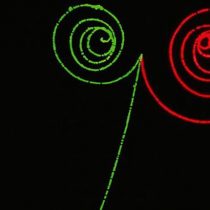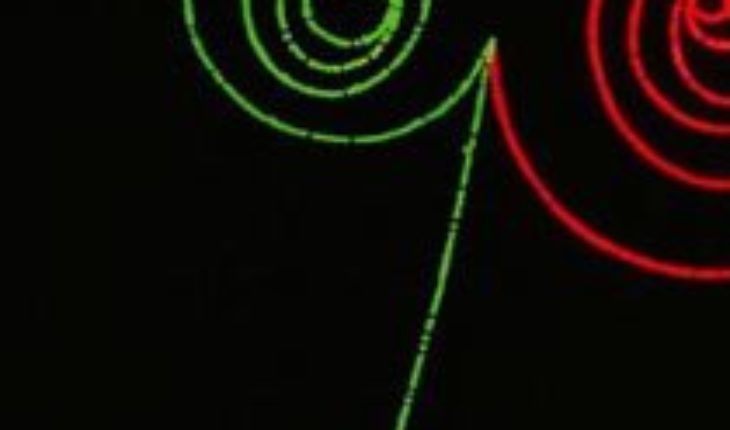
Indeed, tremendously relevant.
But to understand why, let’s start with the basics: what exactly is it?
“It’s similar to normal matter, only it’s the opposite,” cosmologist Andrew Pontzen told the BBC, leaving us almost as confused as it was at the beginning.
“If, for example, you think of one of the components of atoms, the electron, which has a negative electrical charge, its antimatter counterpart is what we call the positron, whose electrical charge is positive.”
Yes: it’s the same but it’s not the same… But can we see it or touch it?
“In principle, you could see it, if we did enough antimatter, but if you tried to touch it you would receive a tremendous shock because the contact between matter and antimatter causes its mutual annihilation; that is, if you shook hands with a person made of antimatter, you and she would probably die.”
If all this sounds strange to you, I warn you that there is more to come, but it is not worth giving up on the fascinating.
How did we know of his existence?
The original antimatter idea was conceived by a Cambridge University mathematician named Paul Dirac in 1928.
The English theoretical physicist Paul Dirac (left) talking with his American counterpart Richard Feynman in 1962 at the International Conference on Relativistic Theories of Gravitation in Warsaw, Poland. Paul Adrien Maurice Dirac (1902–1984) used his famous relativistic theory of quantum mechanics to predict antiparticles. Dirac and Feynman won Nobel Prizes in Physics in 1933 and 1965, respectively”His prediction is one of those things that to this day makes me feel strangely disturbed,” confessed physicist Frank Close, author of “Antimatter.”
“Dirac was trying to take the two great theories of the 20th century – Albert Einstein’s theory of special relativity and quantum theory – and apply them to make an electron theory.
“What he noticed was that, strangely, the sums did not add up unless there was an opposite of the electron, which we now call positron.
“I mean, mathematics dictated that electrons couldn’t exist without positrons.”
Three or four years later, positrons were discovered in cosmic radiation that constantly bombards us from outer space.
“What spooks me is that mathematics knew of the existence of antimatter before us,” Close says.
Positrons were detected using fog chambers or Wilson’s chambers, which are essentially boxes filled with supercooled and super-saturated water vapour. As it passes, the particles leave a wake or trace and each one is different: that of the electron, for example, is thin.
Traces of electrons and positrons, part of a particle shower caused by a collision between a neutrino and a neon nucleus. Inward spirals in the anti-clock wise direction are produced by electrons. The others are antielectrons or positronsWhen a magnetic field is applied to them, the charged particles curve in different directions, depending on their energy. The discovery of the positron occurred when a photograph showed that it behaved identically to the electron, but curved in the opposite direction.
So it’s here… But where?
If we know that we are being bombarded by cosmic radiation, and that positrons come to Earth, we must be able to find them out there, right?
Not really. According to Pontzen, it is so difficult to find them that the best way to obtain them is to manufacture them… But how is antimatter manufactured?
“Basically, in the same way that particle physicists do everything: with shocks. That’s the solution they have for any problem!
“If the shock is strong enough, you create a lot of energy and a lot of particles are produced.”
With such a recipe, two decades after the positron, and using the Bevatron, the first particle accelerator, the antiproton – a proton with negative charge – was discovered in 1955.
The Bevatron is a proton accelerator that first began operation in 1954, and produced several important discoveries, including antiproton (1955) and resonances. A year later, the Bevatron produced an antineutron, which joined the growing antimatter zoo.
The first complete anti-atom was created at CERN in 1995, firing antiprotons at xenon agglomerations to create antihydrogen.
But then, if each atom has a double opposite, how big is the antimatter?
“As far as we know, we could generate a complete periodic anti-table, what happens is that it is an immense technological challenge, because you have to manipulate all those subatomic fragments without ever touching them,” Pontzen says.
In theory, yes there’s that periodic anti-table, there could be an anti-planet or an anti-universe.
“Effectively… and that’s one of the great mysteries: if it’s possible to build anything with antiparticles, why is our Universe made of normal particles?” the cosmologist posits.
“Trying to answer that question you get to the deepest mysteries in Physics, which have not yet been solved.
“But essentially one thing that has to be true is that there must have been some way in which the early Universe distinguished between matter and antimatter.
“If it hadn’t been, after the Big Bang, when everything was close to everything, all matter and all the antimatter would have wiped each other out, and what would have been left would be a very boring Universe composed only of radiation.”
Uff!
So we don’t know why the Universe didn’t burst, that is, why the Big Bang wasn’t followed by another Big Bang produced by the encounter between matter and antimatter.
Remember that the contact between matter and antimatter causes their mutual annihilationAnd it is suspected that there must be large areas of antimatter somewhere in the Universe, although we have not yet been able to find them.
In fact, for the past decade, the International Space Station has been trying to detect any traces of antihelion left behind the Big Bang, without success.
As far as we know, everything in several hundred million light-years is made of matter.
So where did the antimatter go?
We don’t know for sure, and anyone who finds out will surely receive a Nobel Prize.
There is a theory that matter and antimatter are not perfect mirrors with each other. And that, over time, those imperfections led to matter beating antimatter to create stars, planets and galaxies.
That’s the way it is.
But we’re not going to leave you with anything but doubt: we have a surprise for you before we finish.
This is a place where you can certainly find antimatter.
Here on Earth
Have you heard of PET scanning?
Its full name is Positron Emission Tomography (PET).
It allows doctors to visualize what’s going on inside your body.
The shock of matter and antimatter inside your body generates photons that doctors can detect. To do so, you’re basically injected with a radioactive marker that travels through your body into your degraded bloodstream to create a positron, and you lie down in a massive tube that has a coil inside.
But for a more scientific explanation of what happens next, we consulted neuroscientist Sophie Scott.
“What happens is that, very soon, the positron meets an electron and they annihilate, and then two photons come out in opposite directions and the coil detects them.
“That’s what we measure. As there’s a lot of blood flowing through the brain, if at that moment you’re using your brain to do a specific task, more blood will be directed to that part of the brain, so changes in the places where we detect those photons give us information about the r areas to accomplish that task.”
This is the most practical use of antimatter, and serves not only for research but also for solving specific medical problems.
“Tumors, for example, tend to have blood flows with different characteristics, so many PET scans are done to detect tumors. They are also used to see how the heart is working, and that kind of thing.”
So, although it remains an enigma shrouded in mystery, and even though we can hardly see it, we must never touch it and we have not even managed to find much, antimatter has helped save many lives.





